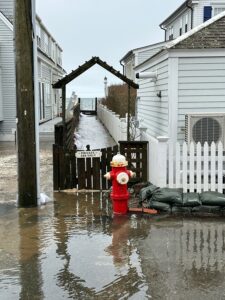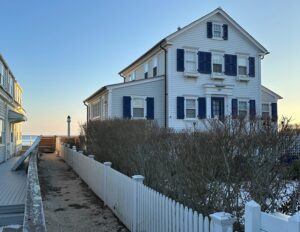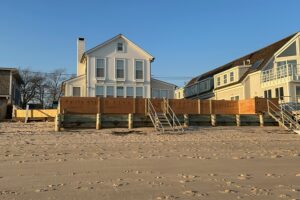PROVINCETOWN — The owners of 599 Commercial St. and two adjacent pathways that belong to properties across the street — one numbered 597A Commercial and one that is part of 596 Commercial — have been granted permission to raise the bulkheads that protect those properties from coastal storms.

The bulkhead behind 599 and 596 Commercial will be raised by three feet, nine inches to a height of 12.5 feet above mean sea level, while the bulkhead protecting 597A Commercial will be raised by about two feet, three inches to 11.6 feet above mean sea level — the same height as an adjoining bulkhead at 597 Commercial.
Receiving permission to expand bulkheads is often difficult these days. A homeowner on Mayo Beach in Wellfleet was recently denied such permission, while the owners of the Blasch house on Chequessett Neck Road in Wellfleet waged an expensive and losing campaign to build a rock revetment along the edge of their property.
Provincetown’s East End is almost entirely fortified by bulkheads already, however, and this particular spot has been the site of saltwater flooding that has repeatedly inundated Commercial Street and nearby properties. At least three winter storms in the last 15 months have sent seawater coursing through the area: one on Dec. 18, 2023, one on Jan. 13, 2024, and another on March 10, 2024.
The house at 599 Commercial St. has already been lifted out of the floodplain, said Eric Larsen, an engineer and consultant who represented the owners of all three parcels before the zoning board of appeals on Jan. 16.
Board members were happy to give permission for the raised bulkheads, although some wanted to know whether the new bulkheads would be high enough.

Vice chair Peter Okun said the board “should be pushing a little harder” to secure review standards for elevation changes for bulkheads, houses, and decks. He wondered if the proposed height of the bulkhead and new decks at the properties would be adequate.
“This section of the neighborhood just gets hammered during southerly storm-type floods,” Larsen said. “We’re raising things as high as they can get relative to what’s there.”
The three properties are mapped by the Federal Emergency Management Agency as being in a “VE15” zone, which is a velocity zone in which breaking waves could reach 15 feet above sea level during a 100-year storm.
Melyssa Nickerson, the town’s environmental planner and conservation agent, said that a low-lying roads study done by the Cape Cod Commission and Woods Hole Group provided a guideline.
“Eleven [feet] is kind of what we’re looking at for the goal of what we should be exceeding,” Nickerson told the ZBA. “Anything below 11 isn’t really going to be effective in terms of controlling floods.”
The elevations described by Nickerson are also heights above mean sea level — not the “mean low low water” mark from which tide charts and storm surges are measured. There is about a five-foot difference between mean sea level and “mean low low water” in Provincetown, which means a “12-foot astronomical high tide” here would reach an elevation of seven feet above sea level — four feet below the Cape Cod Commission’s 11-foot guideline.
“Generally speaking, we’re expecting bulkheads to have about a 30-year lifespan,” Nickerson added. “When the bulkheads have to be redone again in a couple of decades, then we can look at elevating further.”
The proposed reconstruction and elevation of the bulkhead across the three parcels should have a significant effect during southwesterly storms, Nickerson said. While bulkheads do pose a general risk of reflecting wave energy and increasing erosion, that has to be weighed against flood risks, she said.
Erosion concerns are “something that is weighed whenever a project like this comes to the conservation commission,” Nickerson said. “These plans have already come to the conservation commission and been approved.”
Larsen said the bulkhead work will be done first, followed by construction of the elevated decks and stairs. Work will begin as soon as winter storm season ends, he said.
The conservation commission and historic district commission have already reviewed the work plans, and the special permit from the zoning board was the final review for the bulkhead project.
Setting Standards
In a phone interview following the Jan. 16 meeting, Nickerson, who advises the conservation commission and the town’s coastal resiliency advisory board, said the town is working on a coastal resilience plan that should be published in May. The recommendations in that plan could then be incorporated into decisions at the conservation commission and zoning board of appeals.

Provincetown may be unique when it comes to coastal defenses, she said.
“The Wetlands Protection Act is very strict on properties that do not already have a bulkhead, because of our protections for coastal banks and coastal dunes,” she said. “Luckily, in Provincetown we have very few properties that are not already protected, so most of the shoreline is already armored.”
Mark Adams, a member of both the conservation commission and the coastal resiliency advisory board, said it’s important for local boards and the public to have some standard guidelines.
“We can’t all have our coastal engineers and consultants coming up with different standards,” Adams told the Independent. Property owners will increasingly need to weigh their risks, and for many, “I think this is just going to be a maintenance decision, like replacing a roof or anything else.”
While individual homeowners can manage their risks, there are things towns can do, too, Adams said. “People need to move critical infrastructure to the attic,” while “towns can elevate streets, which would help people on the upland side,” he said.
Change is difficult in historic districts but can become necessary, Adams added. “I don’t buy the idea that we can’t change things because there is a moment in history we love.”
